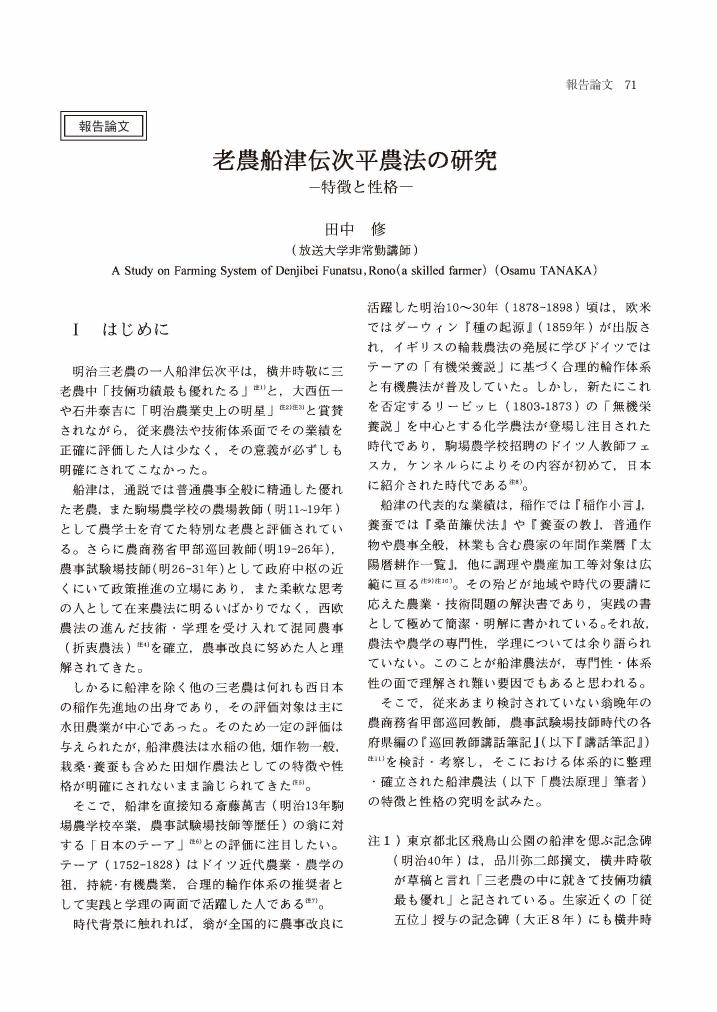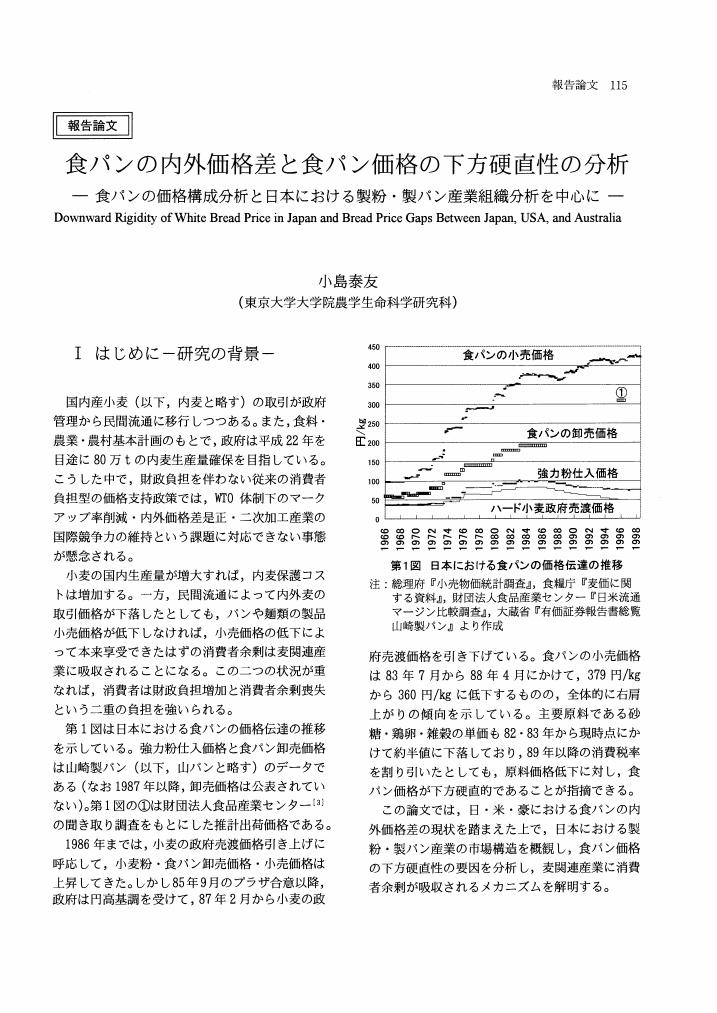1 0 0 0 OA 雇用就農者の就業意識の形成プロセスに関する分析
1 0 0 0 OA 酪農経営における疾病と乳牛淘汰に関する分析
1 0 0 0 OA 農業経営研究の原点を考える
- 著者
- 津谷 好人
- 出版者
- 日本農業経営学会
- 雑誌
- 農業経営研究 (ISSN:03888541)
- 巻号頁・発行日
- vol.46, no.3, pp.1-5, 2008 (Released:2012-10-29)
1 0 0 0 OA 降雨がキャベツ収穫作業体系に与える影響評価
- 著者
- 塩谷 幸治
- 出版者
- 日本農業経営学会
- 雑誌
- 農業経営研究 (ISSN:03888541)
- 巻号頁・発行日
- vol.40, no.1, pp.102-105, 2002 (Released:2012-10-29)
- 参考文献数
- 1
1 0 0 0 OA 老農船津伝次平の「底破法」と畑二毛作論
- 著者
- 田中 修
- 出版者
- 日本農業経営学会
- 雑誌
- 農業経営研究 (ISSN:03888541)
- 巻号頁・発行日
- vol.52, no.3, pp.1-11, 2014-10-25 (Released:2017-01-16)
- 参考文献数
- 40
- 被引用文献数
- 2
After reviewing Denjibey Funatsu’s (c.1832-1898) “TeihaHou” (subsoil break) farming and double cropping system ideas for upland field during the Meiji period, it can be said to be a system for promoting “drought resistance, deep and intensive cultivation method” through the use of manual cultivation (do not deny the plowing by animal power), inter-cropping, deep cultivation (subsoil break at 4-5 years intervals) and double cropping.In the early Meiji period, Funatsu’s farming system thus helped establish more extensive cash crop cultivation. At the same time, his farming system intended to improve the relationship between the main winter crop - wheat and summer crops - upland rice, taros, potatos, sweet potatos, peanuts, eggplants, and so on, through double-cropping. This farming system contributed to the development of intensive small-scale farm management of a diversified crop rotation. And this type of farm management became dominant upland in the Kanto region until the High Growth period of the 1960s.It is said that during the latter part of the Meiji period the so-called “Meiji Farming System,” namely a “modern farming system” characterized by well-drained paddy fields and deep plowing by horse power, with heavy manuring and double cropping use of paddy field, was established. However, this understanding is biased towards paddy cultivation and lacked a proper understanding of the role of upland cultivation. Thus, an understanding of Funatsu’s farming system should be incorporated.
1 0 0 0 OA 老農船津伝次平農法の研究
- 著者
- 田中 修
- 出版者
- 日本農業経営学会
- 雑誌
- 農業経営研究 (ISSN:03888541)
- 巻号頁・発行日
- vol.51, no.1, pp.71-76, 2013-06-25 (Released:2016-06-01)
- 参考文献数
- 21
1 0 0 0 OA アフリカの小規模家族農業における経営計画モデルの構築
- 著者
- 小出 淳司 山田 隆一 大石 亘
- 出版者
- 日本農業経営学会
- 雑誌
- 農業経営研究 (ISSN:03888541)
- 巻号頁・発行日
- vol.56, no.3, pp.1-12, 2018-10-25 (Released:2019-11-01)
- 参考文献数
- 10
In this study, we develop a farm management model that incorporates the livelihood structures of African smallholders and their farming conditions. The model is based upon a comprehensive linear programming approach using smallholders’ farm and non-farm data collected in different agroecological zones of the Nacala Corridor, Northern Mozambique. With the model, we examine optimal crop combinations in each zone that maximize the total income among smallholders depending on their available resources and farm risks. The results suggest that upland crop diversification is effective in increasing the income in zones with relatively high production and market risks. The result also attaches importance to increasing the production of the most lucrative beans and tubers cultivated in each zone for livelihood improvement, as well as increasing the major food staples produced in order to achieve food self-sufficiency, especially among those with more than 1 hectare of farmland. Those with less than 1 hectare of farmland would also derive improved livelihood from expanding the cultivatable area, which is feasible considering actual land and labor availability. Given the current level of productivity, however, the next generation would face food shortages and farm economic decline as farmland area is reduced as a consequence of land division after inheritance. Further efforts should thus be geared toward evaluating productivity-enhancing cropping systems and technologies that reflect the relevant data into such a model as established in this study.
1 0 0 0 OA 施設花き生産現場における改善活動の導入とその効果
1 0 0 0 OA 農業法人の輸出取組と経営規模・収益性
1 0 0 0 OA 農地流動化に対する転用期待の影響に関する定量分析
1 0 0 0 OA 現代農業における家族経営の論理
- 著者
- 岩元 泉
- 出版者
- 日本農業経営学会
- 雑誌
- 農業経営研究 (ISSN:03888541)
- 巻号頁・発行日
- vol.50, no.4, pp.9-19, 2013-03-25 (Released:2015-05-25)
Japanese farming entities were characterized as family farms for a long time. Recently, however, family farms are relativized in the context of the diversification of types of farming entities. The definition of family farms has become vague despite agricultural policies to promote the establishment of vital family farms as a new structural policy target. We can observe the polarization of farming entities ranging from large scale farm businesses to small and rather small scale family farms throughout the world. In this symposium, we discussed first the changing internal and external factors of Japanese family farms. Second, we pointed out the roles and significance of family to farming business. Third, several features regarding the future of Japanese family farm are argued. Fourth, we presented the problems of family farms in a globalized economy.
1 0 0 0 OA 農業における「企業経営」と「家族経営」の特質と役割
- 著者
- 内山 智裕
- 出版者
- 日本農業経営学会
- 雑誌
- 農業経営研究 (ISSN:03888541)
- 巻号頁・発行日
- vol.48, no.4, pp.36-45, 2011-03-25 (Released:2015-03-20)
- 参考文献数
- 26
- 被引用文献数
- 1
This study revealed that there is no definite line of demarcation between "corporate farming" and "family farming." A lot of networking organizations and franchise organizations are observed in "family farms." Simultaneously, there are few cases of "corporate farming" that have absolutely no family elements. Nevertheless, across countries and regions, almost all farm businesses share features of both "somewhat familial" and "somewhat business-oriented."In the USA, there are arguments for and against "corporate farming", and some states restrict corporations from entering farming by prohibiting them from acquiring farmland. The main reasons against "corporate farming" are concerns about (1) a decrease in the number of family farms, (2) rural economy decline, (3) monopolistic and oligopoly markets, (4) environmental impacts, and (5) animal welfare. However, in fact, a main cause for these changes could well be technological changes, while "corporate farming" may not always be the main cause. On the other hand, a vital condition for "corporate farming" in crop production is economies of scale, with a previous study suggesting that economies of scale have been observed in very large family farms, and thus the viability of non-family corporate farming may be verified even in the USA. Another issue being discussed is the definition of "family farm." If the definition is changed with respect to land ownership, labor and farm size, the number of farms that could be classified as "family farm" would be limited substantially.When "corporate farming" and "family farming" are considered, family business studies should be focused. Family business studies observe any firms that are owned in some form on a family-basis, and explore the issues including governance through family and business succession. Farm businesses and family businesses have a lot in common, such as their attitudes to enhance their relationship with the local community. It will become important to consider the viability of farm business development by applying the concept of family business studies.In crop production, it is anticipated that the mainstream of farm businesses will be based on family farms, at least for the time being, and the conditions for increased non-family corporate farming are limited. Therefore, in farm business management studies, it is important to contribute to the development of sustainable business models in any farm businesses that are operated with sincerity. It is also a vital effort to accumulate studies to solve urgent problems in "farm family businesses," including farm succession, family governance, and obtaining business resources in order to put "corporate farming" in perspective.
1 0 0 0 OA 農業経営の外部環境のマネジメント
- 著者
- 木南 章
- 出版者
- 日本農業経営学会
- 雑誌
- 農業経営研究 (ISSN:03888541)
- 巻号頁・発行日
- vol.38, no.4, pp.15-23, 2001 (Released:2012-10-29)
- 参考文献数
- 24
1 0 0 0 OA 産地形成に寄与する実践コミュニティの役割
1 0 0 0 OA 食パンの内外価格差と食パン価格の下方硬直性の分析
- 著者
- 小島 泰友
- 出版者
- 日本農業経営学会
- 雑誌
- 農業経営研究 (ISSN:03888541)
- 巻号頁・発行日
- vol.39, no.2, pp.115-118, 2001 (Released:2012-10-29)
- 参考文献数
- 3
1 0 0 0 大規模稲作経営における有機栽培と米販売
- 著者
- 宮武 恭一
- 出版者
- 全国農業構造改善協会
- 雑誌
- 農業経営研究 (ISSN:03888541)
- 巻号頁・発行日
- vol.52, no.1, pp.49-54, 2014
大規模稲作経営においては,米価低迷が続く中で,規模拡大を加速するとともに米の直接販売を強化する動きが広がっている(納口2005,西川2012)。しかし,米販売に関しては,改正食糧法の施行以降,単位農協も直接販売を進めるために,こだわり米の生産に注力しており,大規模稲作経営が米の差別化を図るためには,一層の工夫が求められている。そうした差別化製品の有力な候補として,JAS有機米がある。農水省の委託調査によると,農薬と化学肥料を削減した特別栽培米に関しては,卸売り・小売り・外食向けの場合,明確な高値傾向はみられず,消費者への直接販売の場合は,むしろ一般小売価格よりも安値で販売する傾向がある(食品需給研究センター2009)。一方,JAS有機米に関しては,一般米と比べて1.6倍程度の高値を維持しているからである(MOA自然農法文化事業団2011)。
- 著者
- 恒川 磯雄
- 出版者
- 全国農業構造改善協会
- 雑誌
- 農業経営研究 (ISSN:03888541)
- 巻号頁・発行日
- vol.51, no.2, pp.31-36, 2013-09-25
- 参考文献数
- 5
2011年度の農業白書には,国産粗飼料の生産拡大を図る上で受託組織(コントラクター)等による生産の外部化,労働負担の軽減及び作業の効率化・低コスト化を促進することの重要性と作業受託経営体数の大幅な増加が指摘されている。コントラクターについては,特に北海道の酪農経営を中心に飼養規模拡大に伴う飼料生産部門の外部化の担い手として展開してきた。2008年時点のコントラクターによる飼料生産作業受託面積は北海道約10.8万ha(13.4ha/利用1戸),都府県で約1.4万ha(同1.2ha),またコントラクターの作業内容は北海道で飼料作物関連の比重が大きいのに対し,都府県では飼料生産以外の作業を兼営する割合が高いという特徴がある。地域別では九州と東北で都府県全体の7割を占める。コントラクターの意義と活動状況の類型化,組織運営上の課題等はすでに福田によって詳しく整理され,組織の法人化や経営問題の重要性の指摘がなされている。また,全国コントラクター等情報連絡会議などにより各地の情報も蓄積されてきた。ただし従来の紹介事例には活動期間が短いものも多く,活動体制以外の,組織体の経営経済・収支実態や運営上の課題については未解明の点も多い。さらに戸別所得補償政策下の新規需要米生産への助成拡充により飼料イネ(これによる発酵粗飼料を以下ではWCSと表記)や飼料米等の作付面積が急拡大するなど,水田の畜産的利用をめぐる最近の情勢も変化している。わが国畜産の最大の課題が飼料自給率の低さにあること,その一方で水田転作政策下でその畜産的利用が大きな意義を有することは縷々指摘されてきたが,最近の政策展開と新技術の開発により,水田を利用した耕畜連携の可能性は増大している。府県でのコントラクターによる飼料生産は九州の畑作地帯などで先行しているが,耕種農家による生産を考えると,今後は水田地帯におけるコントラクターの活動が重要性を増すと考える。その場合,飼料を利用する畜産経営も大規模化しており,これに対応した機械施設投資や運営コストの増大,経営持続に向けた管理運営の必要性を踏まえると,飼料を生産するコントラクター側にも一定の組織規模と経営的な安定性が求められよう。こうした意味でコントラクターの組織体制が整った水田利用型耕畜連携に関して,今のところ少数ではあるが先駆的な取り組みも現れており,今後の方向を示すものと考える。そこで本稿では代表的と思われる2つの事例を取り上げ,耕種・畜産双方との関わりの下でどのように組織体制が展開し経済的基盤が形成されてきたのかを明らかにすることを目的に検討を試みる。
- 著者
- 内山 智裕 西嶋 亜矢子
- 出版者
- 全国農業構造改善協会
- 雑誌
- 農業経営研究 (ISSN:03888541)
- 巻号頁・発行日
- vol.49, no.3, pp.1-11, 2011-12-25
- 参考文献数
- 17
- 被引用文献数
- 1
米国におけるとうもろこし・大豆の最大の生産地であるアイオワ州における穀物流通業者を調査対象として,これら業者の動向と我が国の今後の食料の安定供給に向けた展望および含意を明らかにすることを目的とする。
1 0 0 0 OA 農業経営の第三者継承の特徴とリスク軽減対策
- 著者
- 柳村 俊介 山内 庸平 東山 寛
- 出版者
- 全国農業構造改善協会
- 巻号頁・発行日
- no.152, pp.16-26, 2012 (Released:2013-10-08)









